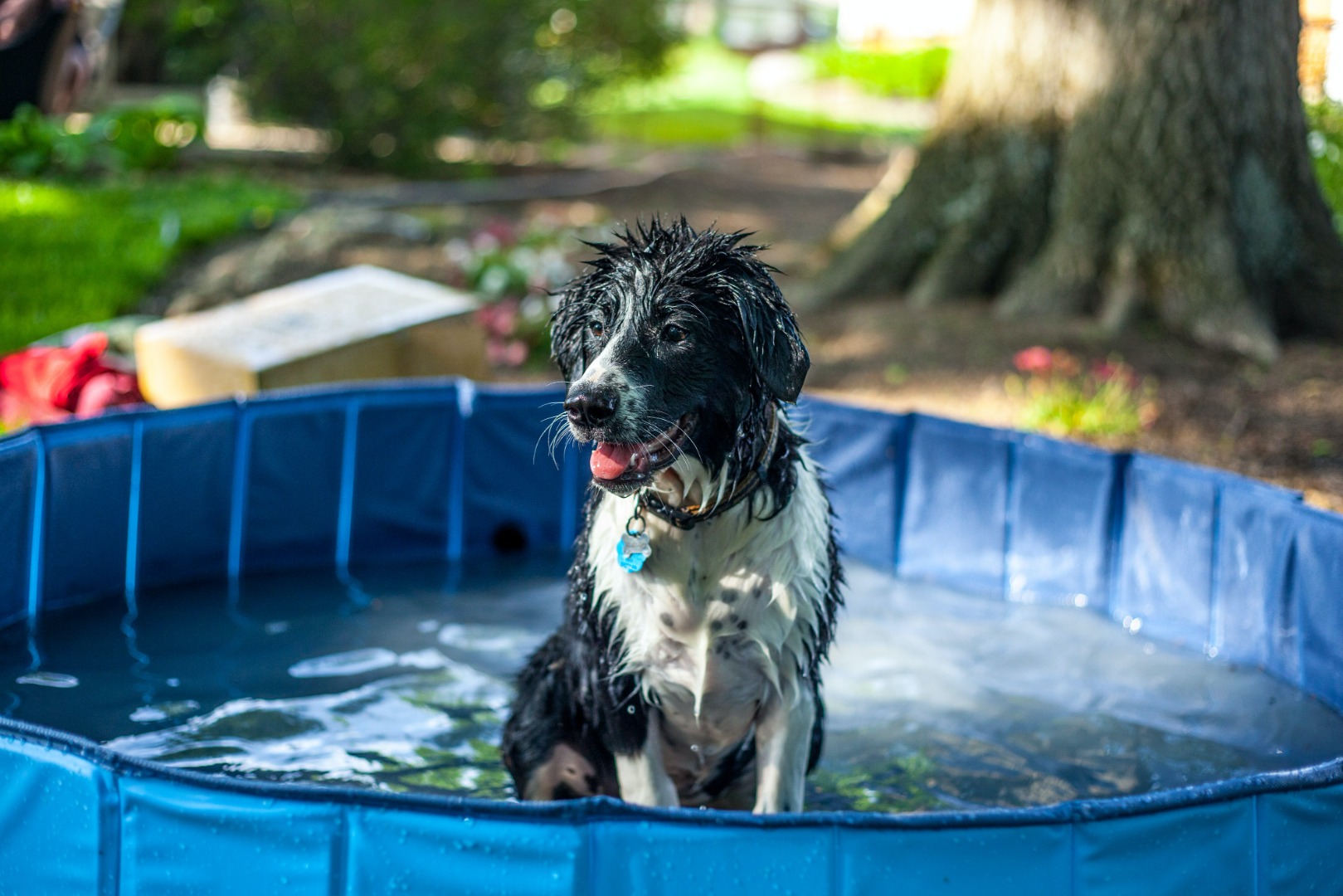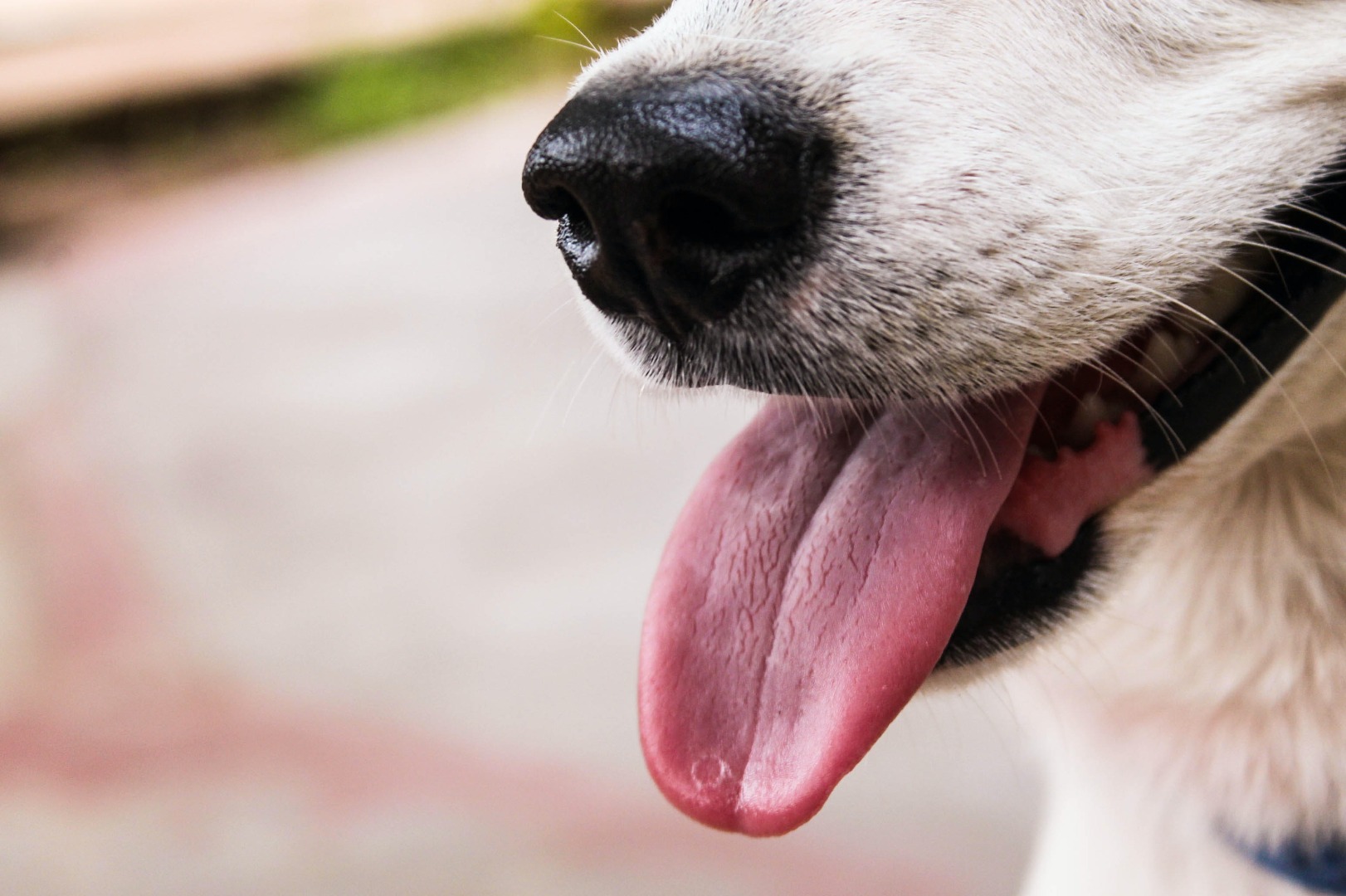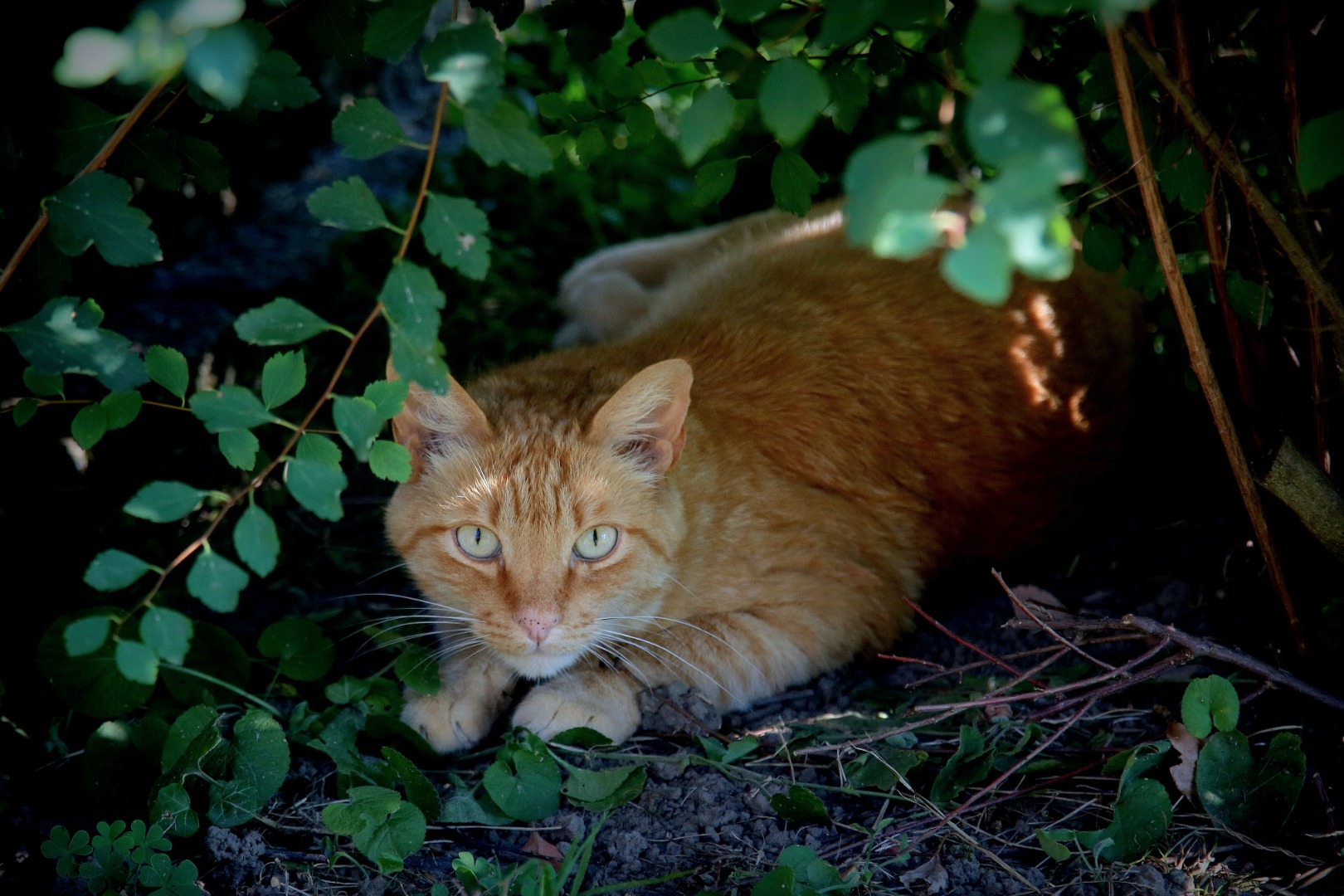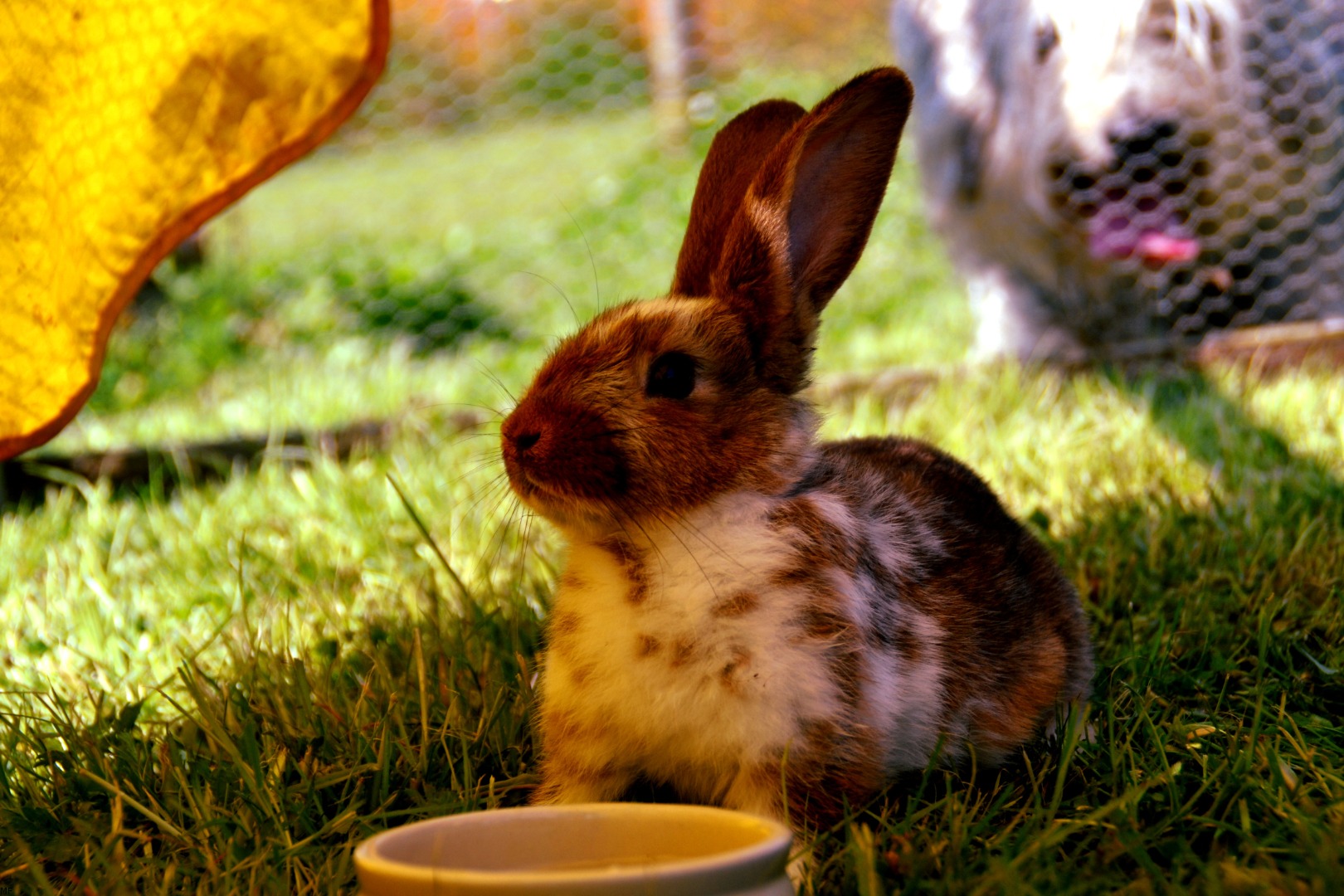As we enjoy the Summer sunshine, it is important to remember our pets are less able to tolerate the heat and humidity of the season.
We regulate our body temperature by sweating, pets go about it in a different way. Dogs do not sweat in the same way that we do, although they do produce very small amounts of sweat from the pads of their paws. The main way in which dogs regulate their body temperature is by panting, which draws cooling air into the body to drop the core temperature, and also by drinking water, which again cools the body and also hydrates them. Cats have sweat glands in their paws, you might notice a damp pawprint on the vet's table during an anxious visit! Their sweat glands are not that effective so they find other ways of cooling down, like sleeping in a shaded flower bed.Rabbits don't sweat and are suscepible to heat stroke. To help them cool down, they lose heat from the surface of their ears, but if the environment is hot, this becomes ineffective. Like rabbits, Guinea pigs don't sweat and lose heat from their ears ( you'll notice that they don't have hair on their ears!). Again this isn't particularly effective and they can easily overheat.
Pets rely on their owners to ensure they don't overheat.
What is heat stroke?
Heat stroke (hyperthermia) is a condition that occurs at a point where an animal can no longer regulate their body temperature or cool themselves down. Their temperature becomes dangerously raised. It generally occurs in the summer months when the outside temperatures are high. Any animal can develop heatstroke but some are more susceptible. Dogs that are overweight or ones that have a thick coat are particularly vulnerable as are short nosed breeds of dog (brachycephalics) such as a Bulldog, Pug, Boxer, Pekingese and Shih-tzu. Elderly pets and those with heart and lung problems also have an increased risk.
Situations that can quickly lead to heat stroke;
- Too much exercise or vigorous play during hot weather - whether it is hot and sunny or cloudy and humid, a rise in temperature affects our pets.
- Not drinking enough water or lack of access to drinking water.
- Being out in direct sunlight and unable to find shade.
- High air temperature ( heat wave)
- Being enclosed in a car, shed, conservatory or other overheated enclosure where the temperature is hot.
Preventing heat stroke in pets
It is vital to monitor your pet closely when it is hot to see how they are coping with the heat. Some of the precautions to take during the summer include:
- Not walking your dog or encouraging vigorous play during the hottest part of the day; walk in the early morning and the evening when the weather is cooler. Pavements also get too hot for paws
- In extremely hot weather avoid taking your dog out altogether
- Take water out on dog walks with you so that you can give them a drink
- Ensure that your pet has access to clean, fresh water at all times
- NEVER leave your pet shut in a car, shed, conservatory, caravan or other small space for any amount of time, even for just a few minutes. Your pet can become dangerously overheated
- Make sure that your pet can get out of direct sunlight. Provide access to cooler, covered, shaded areas - some dogs and cats insist on lying in the sun, discourage this!
- Provide a cool room in which they can retreat into - if necessary close the curtains to keep the sun off the room and ensure that there is plenty of ventilation (good air-flow) and fresh water readily available. Some pets like to lie on a cooling mat or provide a fan
- Let your dog have a splash around in a dog paddling pool situated in the shade ( supervise at all times)
- Groom your pet regularly. A healthy, groomed coat helps your pet to regulate their body temperature and cope with the heat in summer
- Outdoor hutched pets must have access to shade and drinking water at all times
- Remember that some dogs, particularly those with white fur or pink skin may be prone to sunburn - take this into account when taking them out in the sun. Cats with white ears are also prone to getting sunburn on the ear tips.You can buy pet safe sun cream - always read the label.
Photo by Rob Waller: www.pexels.com/photo/a-wet-dog-in-a-pool-8195255
Identifying heatstroke in dogs;
Even if you take all possible precautions and do what you can to help your dog keep cool, it is important to be able to identify the symptoms of heatstroke in the early stages in order to take prompt action. Heatstroke can quickly progress to become a life-threatening emergency.
During the early stages of heatstroke your dog may appear restless, have excessive thirst, be breathing heavily and faster and look generally unhappy. They might stagger about but can appear listless and lethargic too. They will begin to pant excessively and for a prolonged period of time, or pant recurrently without getting any relief. As heatstroke progresses they may drool more than usual from the mouth and their gums or tongue may appear a dark red or purple colour. A high body temperature and elevated heart rate also accompany heatstroke in dogs. Heatstroke often progresses very quickly and can soon advance to confusion and disorientation, collapse and fitting. The dog may also vomit or lose control of their bowels and bladder.
Heatstroke is a veterinary emergency, and not a condition that can be left to resolve itself.
 photo courtesy of pexels-sibi-mathew-1080355.jpg
photo courtesy of pexels-sibi-mathew-1080355.jpgWhat to do for dogs with heat stroke;
- Immediately move your dog to the shade or indoors to a cool area
- Apply cool water, either directly by slowly pouring water on them with a jug or by using a cloth/ sponge to wet the body. Pay particular attention to the stomach, inner thighs, armpits, head, neck and footpads. (DON'T cover the dog with a wet towel as this can cause them to warm up)
- If a hose pipe is available, use a fine, gentle spray to wet your dog. (Make sure that you run water through the hosepipe first before applying it to your pet - any water residue in a hosepipe that has been sitting in the sun can be scalding hot so be sure to check the water temperature before using it)
- If you have a paddling pool, stand them in it and wet them as described above ( Do NOT leave them unattended in case they collapse)
- If you have brought your dog indoors, if able to, stand them in the bath so that their feet are stood in cool water and continue to slowly wet their body. Again, supervise at all times. Do not suddenly submerge them in water as this can shock them
- Offer your dog water to drink but don't let them drink too much at once. Small sips are ideal. However, don't force them to drink
CALL YOUR VET for further advice and to arrange for your pet to be checked, (even if they appear to be recovering).
Cats and the heat
Cats will generally cope better with hot temperatures. They usually seek out somewhere to rest, often on a cold surface like tiles that they can stretch out onto or under a bush in the garden. Cats also lick the fur over their bodies to distribute saliva that will evaporate to cool them, much like sweat would do.They will also have a drink of water so ensure there is a bowl readily available.
** A heat stressed cat will pant and this should not be ignored **
A cat that has heatstroke will show similar symptoms to a dog - restlessness, pacing, agitation, drooling, panting, weakness, vomiting. Again it is vital that you move them to a shady, cool area and apply cool water using a cloth or sponge to the groin, paws and neck. If available, use a fan to help cool them down. Offer small amounts of water to drink. CALL YOUR VET.

Photo by Giannino Nalin: https://www.pexels.com/photo/an-orange-tabby-cat-10427159/
Rabbits and Guinea pigs
Rabbits and Guinea pigs being unable to sweat, must have plenty of shade and good airflow.
Position enclosures/hutches in a cool place out of direct sunlight such as under a tree and more shade can be created by adding a tarpaulin or towels to create a sun shade. A garden unbrella is also a good idea to use. Remember that shade changes position throughout the day so check that the enclosure is suitably protected. More shady spots can be provided within the enclosure using a cardboard box for example with a couple of openings cut into it for added ventilation. Provide fresh water at all times in both a drinking bottle and ceramic dish.
Signs that a rabbit or Guinea pig is hot include lethargy, breathing heavily, puffing, a wet nose, drooling, weakness, reluctance to move.
Immediately move them to a cool area and apply cool water to their ears, groin and feet using a sponge/cloth. Offer them water to drink. Do not plunge them in water as it can shock them. CALL YOUR VET!
Click the link for some tips on summer outdoor bunny care - (courtesy of Bluecross.org.uk)
How to keep your rabbit cool
 Photo by Max from Pexels: https://www.pexels.com/photo/brown-and-white-rabbit-on-green-grass-106921/
Photo by Max from Pexels: https://www.pexels.com/photo/brown-and-white-rabbit-on-green-grass-106921/Rodent and bird cages
Ensure that rodent cages and bird cages are kept out of direct sunlight and are not left in a conservatory. Make sure that your pet has access to fresh water at all times.
Wildlife - Don't forget to leave a shallow dish of water out for wildlife visiting your garden!